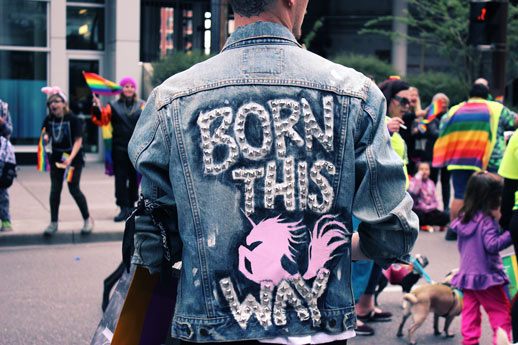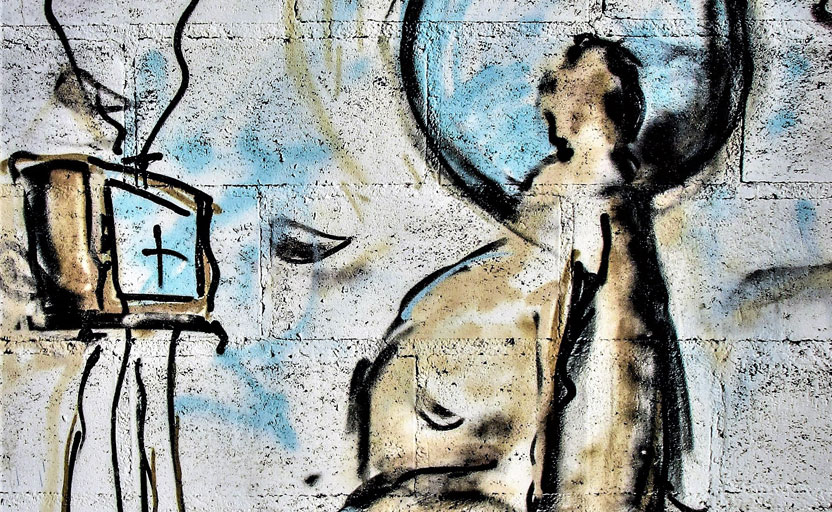
What to do when people use religion as an excuse for homophobia

What was the function of religion? Religion was the telling of stories that helped us make sense of the world. It attempted to address all our fears and give us answers that make life purposeful. It was the means of gathering within a community and feeling connected to something bigger than ourselves. It was a means of communicating the norms and expectations of society, which helped define the behaviour to which we should conform.
What is the function of the media? Is it so different? Media aims to give us the answer to the questions that challenge us each day. Through TV programmes, we form a community of fans that help us feel like we belong – just look at the audience for Star Trek and how the level of worship is nothing short of a religion. It is gives us figureheads to look up to, who tell us how to behave and conform within our society. In short, media is our new religion.
The obvious manifestation of media as a new religion is the TV evangelist. These are people who have recognised that television and social media have the power to reach a mass, global audience, which goes far beyond the traditional pulpit. It is the creation of a preacher as a media sensation. The added glitz and glimmer of the cameras makes the persona of the preacher more alluring and creates an almost cult-like adoration for the media star.
In the 1950s Horton and Wohl recognised a phenomenon called parasocial relationships. These relationships are one-way but for the television viewer it feels far from an unrequited interaction. The researchers spotted that television hosts were able to engage on a personal level with the audience and make them feel special – because of the intimate interaction with the camera.
The TV evangelist is an example of how religion can evolve and become more personal, even though it is on a mass scale. The evangelist’s audience all believe themselves to be in an intimate one-to-one relationship with the preacher, as Horton and Wohl noticed with presenters on early television. This makes the reach of the evangelist into the lives of their congregation stronger and more pervasive that traditional people of religion who preach within a set community.
Yet, this is not really the true reason why the media has become the new mass. The religion being touted by most of those who enjoy adoration are nothing to do with spiritual connection and a sense of a higher purpose. Look closely at the cult of the Kardashians. The Kardashians are the perfect example of how personalities can take on many of the facets that religion used to fulfil in our lives.
The Kardashians is a reality TV programme. We learn everything about their lives and we believe that they are our friends. This idea of friendship is further exaggerated by Kim Kardashian’s presence on Facebook and Twitter – where her followers can feel like they are interacting with her directly. Even the vocabulary, followers, gives the sense of a new religion.
Kim Kardashian has mastered the art of her influence by making millions of dollars dropping in recommendations for how her audience should live their lives. She mentions products and services she uses in her everyday life. This product placement is a powerful marketing tool that plays on the need of the audience to get solutions to life from a guiding figure – even if this guidance is on the superficial decisions of make-up, hair colour and clothing.
The guidance Kim Kardashian gives is not spiritual but cultural. She leads her followers by showing how they should live their lives on a day-to-day basis to maintain a certain image – a certain acceptability.
You may feel uncomfortable with this proposition. After all, it suggests that the Kardashians have an equal influence to let’s say a Mohammed or to a Jesus or a Buddha in the way we live. You may argue that this is the ignorance and naivety of the young and not the wisdom and depth of lived experience.
Yet, the mass of the media is consumed as much by the learned as it is by the innocent. Look at the way we look to the media to give us a window to the world and to define our sense of what is right and what is wrong. We allow them to tell us our devils and to portray to us our angels.
Look to the obvious abuse of social media with fake news. Enough people thought there was enough possibility that this news would sway votes that they paid good money. Groups in our population are targeted for information and this information is not always true or well sourced. People take in the stories and share the stories, allowing it to shape their faith in the people who lead us. These snippets of fiction could be the new parable – meant to be taken metaphorically and interpreted – but often taken as facts about the way the world is shaped.
In the current climate of fake news and targeted advertising, it challenges our faith in the validity of the media as a source for our values. However, realistically we only ever see the world we live in and the meaning we should get from this through the lens of a camera. Do we attempt to interpret and challenge this view? Some do, in the same way we seek meaning from scripture or the verses of sacred texts. However, do not underestimate how we rely on the media as guidance for how we should live and ultimately why we live.
 Racheal Smith was an English teacher for 20 years and now works as a freelance writer and educator – as she still can’t get away from teaching children.
Racheal Smith was an English teacher for 20 years and now works as a freelance writer and educator – as she still can’t get away from teaching children.
Follow her on LinkedIn